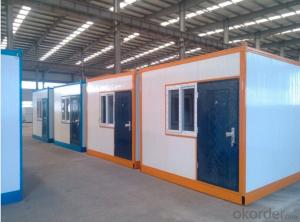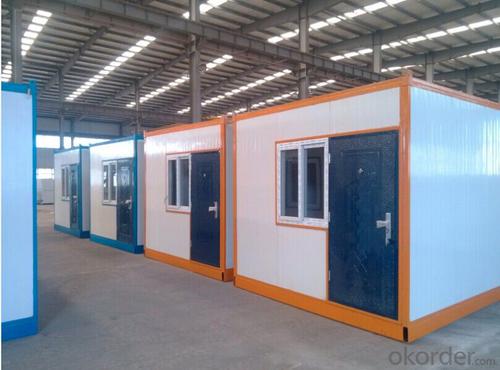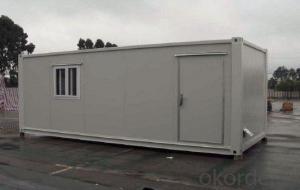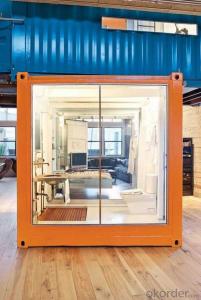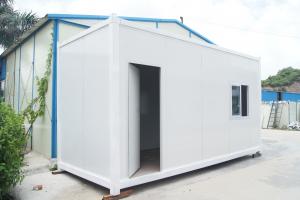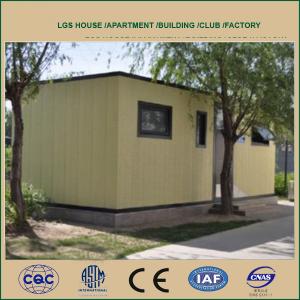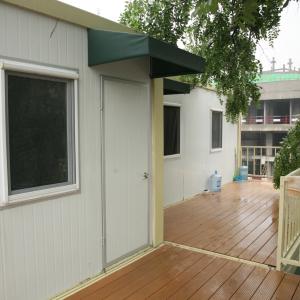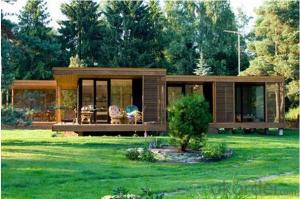China Manytimes usage Portable Container Washrooms
- Loading Port:
- Tianjin
- Payment Terms:
- TT OR LC
- Min Order Qty:
- 1 pc
- Supply Capability:
- 10000 pc/month
OKorder Service Pledge
OKorder Financial Service
You Might Also Like
China Manytimes usage Portable Container Washrooms
1.China integration activities chamber room
2.Product introduction
The assembled series slope roof prefabricated houses
"Constant" brand series of slope roof assembled prefabricated houses is the company launched a new concept of environmental protection building economical activities, ordinary, standard and luxury type 3 kinds.According to customer demand, in a standard module for space combination, formed the skeleton system USES light steel structure, and to sandwich panels and PU tile forming palisade and roofing system.Realize the simple and beautiful, the construction fast, use safety, the standard of general overlay idea, make the overlay houses into an industrialized production, inventory, for repeated use of stereotypes housing products.
Sex can
Reliable structure: light steel system of flexible structure, safe and reliable, satisfies the requirement of building structure design codes.
Tear open outfit is convenient: housing can be repeatedly disassembling, repeated use.The installation process need only simple tools.Average per person per day to install 20-30 square meters, 6 people a team, 2 days to complete 3 k standard prefabricated houses 1 x 10 k.
Beautiful decoration: housing overall beautiful, bright color, texture soft, board face level off, have good adornment effect.
Flexible layout: doors and Windows can be installed in any position, interior partition can be set in any horizontal axis.The stairs set outside.
The structure of the building structure waterproof, waterproof design, does not need to do any other waterproof processing.
Long service life, light steel structure anticorrosion coating processing, normal service life can reach more than 10 years.
Environmental conservation: the reasonable design, easy tear open outfit, can be used many times cycle, low attrition rate, do not produce construction waste, the average annual cost is much lower than other materials of similar houses.
Using standardized components, a variety of specifications: building length and width are to K (1 K = 1820 mm) for the module.Transverse dimensions of mk + 160, the longitudinal size of nk + 160.
With the way
Are widely used in road, railway, construction and other field operation of temporary housing construction;Urban municipal, commercial and other temporary housing, such as: temporary office, conference room, headquarters, dormitory and temporary stores, temporary schools, temporary hospitals, temporary parking area, temporary exhibition hall, temporary filling stations, etc.
3.Assemble series flat roof prefabricated houses
"Constant" assembled series flat roof prefabricated housing is through making full use of their own strength of sandwich wall panel and roof panel, after pulling, bolts, self-tapping screw connection and finalize the design activities of housing system.Can be industrialized production, use, interior decoration, realize the inside and outside is beautiful, fast, safe construction overlay concept, tight sealing, heat insulation, waterproof, fireproof, moistureproof.
Aesthetically pleasing: housing overall modelling beautiful, inside and outside are color decorative plates, good appearance, design and colour collocation to coordinate.
Long use period: normal service life can reach more than 10 years.Convenient transportation, dismantling recycling, environmental savings.
With the way
Are widely used in road, railway, construction and other field operation of temporary housing construction;Urban municipal, commercial and other temporary housing.Such as: temporary office, conference room, headquarters, dormitory and temporary stores, temporary schools, temporary hospitals, temporary parking area, temporary exhibition hall, temporary maintenance, temporary transformer room, temporary filling stations, etc.Other temporary housing areas, such as military logistics temporary occupancy, rescue and relief temporary occupancy, sterile laboratories, isolation rooms, communication substation room.Scenic area of temporary use leisure villa, vacation homes, etc.
Products > > activity control box, the bathroom
Box is by utilizing sandwich wall panel and roof panel connection of their own strength, by screw, bolts, self-tapping screw, wall sandwich plate and the steel structure base housing system composed of roof plate connection.Quick construction, whole movable, especially suitable for municipal facilities and field construction site of the gatehouse, service, etc.
Toilet is mainly is made of light steel structure, caigang sandwich board maintenance material, to give expulsion-typely wastewater and circulating water storage (microbes) drainage way portable toilet.Can be very convenient to install, move, move, especially suitable for streets, sports venues, the use of tourist attractions.
Fence is made of steel structure column, double color sandwich steel or single color pressed steel by bolt connection and into.All of its components are composed of standard parts, the arbitrary assembly, short installation period, the effect is good, the color can be specially made according to the requirements.Repeatable tear open outfit, use, construction waste, beautiful appearance.
- Q: Can container houses be designed with a traditional or historical theme?
- Yes, container houses can certainly be designed with a traditional or historical theme. With the right design and architectural elements, containers can be modified to resemble traditional or historical structures. Various exterior finishes such as brick, wood cladding, or even faux stone can be added to create a more traditional appearance. Additionally, the interior can be designed with vintage or antique-inspired decor, incorporating traditional materials, colors, and furniture to achieve a historical ambiance. Ultimately, container houses offer flexibility in design, allowing for the incorporation of traditional or historical themes.
- Q: Are container houses resistant to earthquakes?
- Yes, container houses can be made resistant to earthquakes by implementing appropriate engineering techniques and reinforcing the structure.
- Q: Can container houses be designed to have a separate entrance?
- Yes, container houses can be designed to have a separate entrance. The modular nature of container homes allows for flexibility in design, enabling the inclusion of multiple entry points to meet the specific needs and preferences of the homeowner.
- Q: Do container houses require permits for construction?
- Yes, container houses typically require permits for construction. The requirements for permits may vary depending on local building codes and regulations. In many jurisdictions, container houses are considered as alternative or unconventional forms of housing, and therefore, they may have specific regulations and requirements that need to be met in order to obtain the necessary permits. It is important to consult with the local building department or planning commission to determine the specific permits and approvals needed for container house construction in your area. This will ensure that your project is in compliance with all applicable regulations, building codes, and zoning restrictions.
- Q: Are container houses suitable for vacation or rental properties?
- Yes, container houses are suitable for vacation or rental properties. Container houses have gained popularity in recent years due to their affordability, sustainability, and versatility. They can be easily converted into comfortable and stylish living spaces suitable for vacations or rentals. Container houses offer several advantages for vacation or rental properties. Firstly, they are cost-effective. Containers are readily available and relatively inexpensive compared to traditional housing options. This makes them an attractive choice for property owners looking to invest in vacation or rental properties without breaking the bank. Secondly, container houses are highly customizable. With some creativity and design expertise, containers can be transformed into modern and stylish living spaces. They can be easily modified to include all the necessary amenities such as bedrooms, bathrooms, kitchens, and living areas, ensuring that the occupants have a comfortable and enjoyable stay. Additionally, container houses are eco-friendly. By repurposing shipping containers, we are reducing waste and promoting sustainability. These houses can also be equipped with energy-efficient features like solar panels, rainwater harvesting systems, and proper insulation, further reducing their environmental impact. Furthermore, container houses are portable and can be easily transported to different locations, making them ideal for vacation or rental properties. They can be placed in scenic areas, near the beach, or in other desirable locations to attract tenants or vacationers. The mobility of container houses also allows property owners to explore different markets and maximize their rental income. However, it is important to consider the potential limitations of container houses for vacation or rental properties. Container houses may have limited space compared to traditional houses, which can affect the number of occupants that can comfortably stay in them. Additionally, noise insulation may also be a challenge, so proper insulation and soundproofing measures may need to be implemented. In conclusion, container houses are indeed suitable for vacation or rental properties. Their affordability, versatility, and eco-friendliness make them an attractive choice for property owners. With proper customization and design, container houses can provide a unique and comfortable experience for vacationers or tenants, making them an excellent investment option for those in the hospitality or rental industry.
- Q: Can container houses be built on a tight budget?
- Indeed, container houses can be constructed with limited financial resources. One of the key benefits of container houses lies in their cost-effectiveness. Used shipping containers can be acquired at a relatively low price, especially if they are in good condition. Moreover, the construction process of container houses is typically quicker and more efficient compared to traditional houses, which can further decrease labor expenses. There are also various ways to economize during the construction and design phase of a container house. For example, incorporating recycled materials for insulation, interior finishes, and fixtures can significantly diminish the overall cost. Additionally, choosing a simpler design and layout can help minimize expenditures. Furthermore, container houses are renowned for their energy efficiency, which can lead to long-term savings. Containers possess natural insulation properties and can be further insulated with economical materials, reducing the necessity for heating and cooling systems. This can result in reduced energy bills and lower maintenance costs in the long haul. To conclude, container houses present a remarkable opportunity to construct a home on a limited budget. With meticulous planning, intelligent material choices, and efficient design, it is feasible to create a cozy and sustainable living space without exceeding one's financial means.
- Q: Are container houses suitable for Airbnb investment properties?
- Yes, container houses can be suitable for Airbnb investment properties. Container houses offer several advantages for Airbnb hosts, such as cost-effectiveness, sustainability, and unique design appeal. These structures can be easily customized and modified to create comfortable living spaces with all necessary amenities. Additionally, container houses can be transported and installed in various locations, providing flexibility for hosts to offer their properties in different areas. Overall, container houses can be a profitable investment for Airbnb properties due to their affordability and potential to attract guests seeking a distinctive and eco-friendly accommodation experience.
- Q: Can container houses be designed with a loft space?
- Yes, container houses can be designed with a loft space. In fact, the modular and versatile nature of shipping containers allows for various design possibilities, including loft spaces. By stacking and configuring containers in a specific way, architects and designers can create multi-level container homes that incorporate loft spaces. These loft spaces can be used as additional bedrooms, study areas, or even storage spaces, maximizing the usable square footage within the container house. Additionally, incorporating a loft space in a container house can provide an open and airy feeling, making the space more comfortable and visually appealing.
- Q: Can container houses be insulated for noise reduction?
- Yes, container houses can be insulated for noise reduction. While shipping containers are made of steel, which is not a great sound insulator, there are several methods to effectively reduce noise within a container house. One common approach is to add insulation materials to the walls, ceilings, and floors of the container. There are various types of insulation that can be used, such as fiberglass, foam, or mineral wool. These materials help to absorb and dampen sound vibrations, reducing the amount of noise that enters or leaves the container. Another method is to install acoustic panels or soundproofing curtains on the interior walls. These panels are specifically designed to absorb sound waves and prevent them from bouncing around the container, thereby reducing noise transmission. Additionally, sealing any gaps or cracks in the container walls can also help to minimize noise infiltration. This can be achieved through the use of weatherstripping or caulk to ensure a tight seal. Furthermore, the choice of windows and doors can also contribute to noise reduction. Installing double-paned windows or using soundproof windows can significantly decrease noise levels. Similarly, using solid-core doors instead of hollow-core doors can provide better sound insulation. It is important to note that while these methods can help reduce noise, complete soundproofing may not be achievable in a container house due to its structural limitations. However, with proper insulation and soundproofing techniques, container houses can be significantly quieter and more comfortable.
- Q: Can container houses be built with a rooftop terrace or outdoor seating area?
- Yes, container houses can be built with a rooftop terrace or outdoor seating area. This is possible by modifying the container structure and adding additional support systems to accommodate these features.
Send your message to us
China Manytimes usage Portable Container Washrooms
- Loading Port:
- Tianjin
- Payment Terms:
- TT OR LC
- Min Order Qty:
- 1 pc
- Supply Capability:
- 10000 pc/month
OKorder Service Pledge
OKorder Financial Service
Similar products
Hot products
Hot Searches
Related keywords
